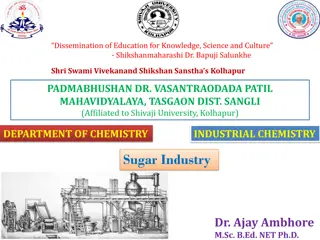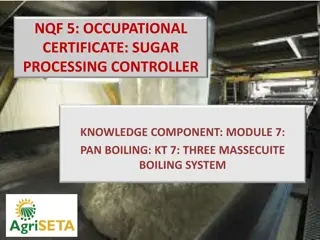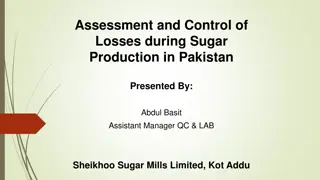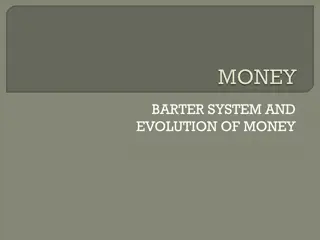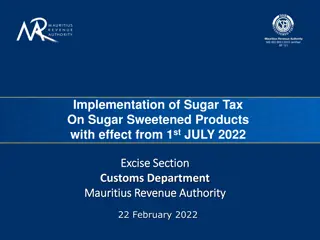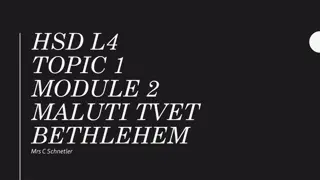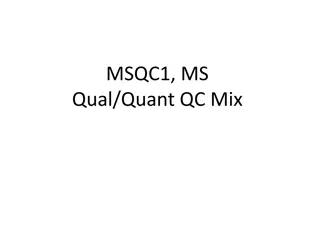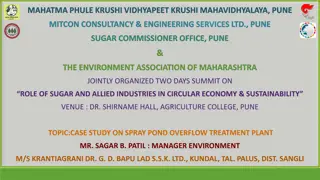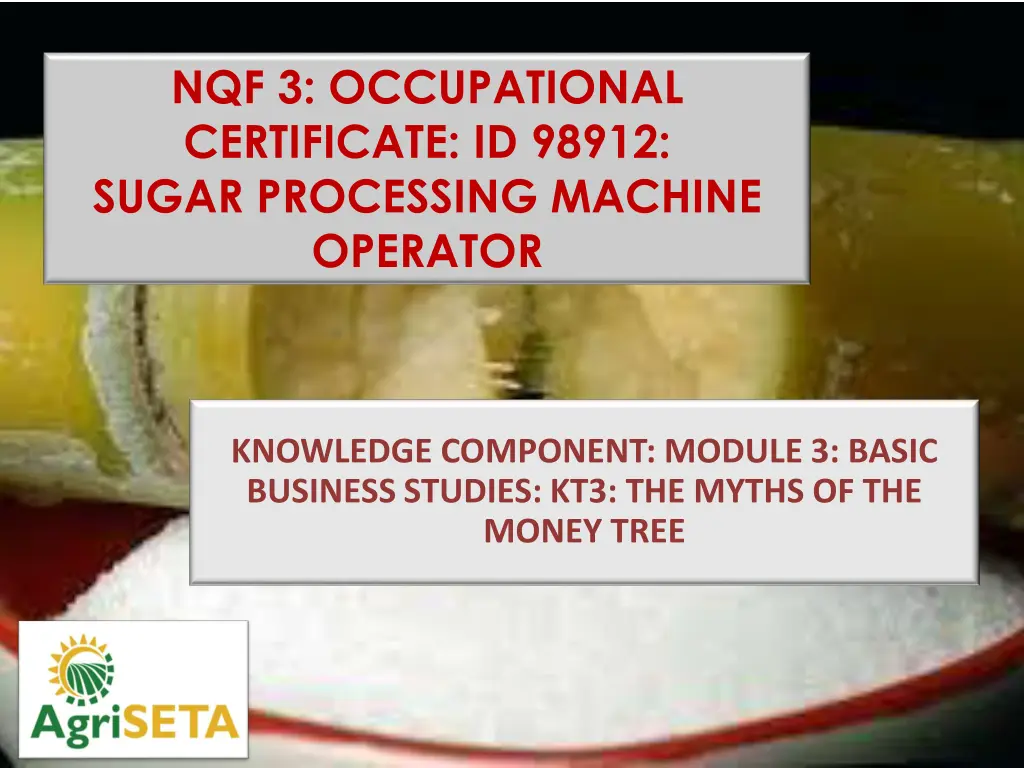
Sugar Processing Machine Operator Knowledge Component
Learn about the basic business studies, including budgeting, income, profit calculations, and machine equipment costs, essential for a sugar processing machine operator. Gain insights into financial planning, efficient resource utilization, and maximizing profit margins in the sugar processing industry.
Download Presentation

Please find below an Image/Link to download the presentation.
The content on the website is provided AS IS for your information and personal use only. It may not be sold, licensed, or shared on other websites without obtaining consent from the author. If you encounter any issues during the download, it is possible that the publisher has removed the file from their server.
You are allowed to download the files provided on this website for personal or commercial use, subject to the condition that they are used lawfully. All files are the property of their respective owners.
The content on the website is provided AS IS for your information and personal use only. It may not be sold, licensed, or shared on other websites without obtaining consent from the author.
E N D
Presentation Transcript
NQF 3: OCCUPATIONAL CERTIFICATE: ID 98912: SUGAR PROCESSING MACHINE OPERATOR KNOWLEDGE COMPONENT: MODULE 3: BASIC BUSINESS STUDIES: KT3: THE MYTHS OF THE MONEY TREE
Money doesnt grow on trees! Profit = Income Expenses The higher the expenses the less the profit Many expenses need to be paid Every employee has a role to play to: Be more efficient Do more, produce more, with less: Time Inputs waste
Budgets A financial plan for the future Includes the expected income (revenues) and expenses (costs) Used in the day-to-day management Agricultural inputs are seasonal by nature Annual budgets can show when shortfalls may occur, so that planning can address these (through overdraft facilities, loans, etc.)
Budgets (cont.) Cash flow budgets are useful for day-to-day financial management. Used to project: When you can expect income and incur expenses Whether you will have enough cash to meet commitments The capital requirements of the business Whether expenses need to be reduced Whether efficiency needs to increase Whether staff need to be reduced
Income and Profit Income sometimes called Gross Revenue Profit = Income Expenditure Profit sometimes called Net Revenue From an income statement, the following can be calculated Gross Value of Production (for each division of the enterprise) Directly allocatable variable cost (of each division of the enterprise) Sundry factory income Gross margins (of each division of the enterprise) Overhead costs External factor costs (e.g. interest paid on borrowed capital, cost of hired equipment) Net increase in value of assets over liabilities due to non-production activities (A)
Income and Profit (cont.) From the previous indices, the following can be calculated: Gross Value of Production for the factory Total directly allocatable variable costs Total Gross Margin for the factory Net Factory Income (NFI) (B) Factory Profit or Loss (NFP) (C) Growth in Net worth (D)
Machine and Equipment Costs Equipment is considered Capital items or Fixed assets Includes: Furniture Computer equipment Cars or trucks necessary for the business Machinery Premises / Property / Factory Recorded in a Fixed Asset Register Subject to depreciation (spreading the cost of the asset over several years for tax benefit purposes)
Manpower Costs Includes: Salaries Wages Allowances Gratuities Contributions to Provident Fund Bonuses Welfare expenses Benefits (health insurance, year-end bonuses, performance bonuses, profit-sharing) Unemployment insurance (UIF) Worker s Compensation Insurance Skills Development Levy Payroll taxes (PAYE) (Due to the cost of accounting, HR or Payroll services Single largest expense of a business Contract labour used to complete seasonal tasks
Material Costs Also called Product Costs Costs incurred to create a product Include: Direct material Direct labour Manufacturing overhead
Material Costs (cont.) Can be reduced by: Substituting lower cost materials where possible Reduce waste Eliminate unnecessary product features Negotiate, negotiate, negotiate Leverage suppliers Transform buyers into suppliers Provide warehouse and distribution services Offer quick payment for lower prices Negotiate long-term supply agreements
Cost of Rework Costs associated with correcting defective, failed or non-conforming product Reasons for sugar rework could include: Equipment malfunction or human error Product specification not correctly communicated (at all or in a timely manner) Product specification manufacturing change not implemented properly Product damaged in transit (during delivery to client) Product damaged in use (perhaps spoiled by water damage in a warehouse) Rework costs include twice of: Labour cost Materials cost Equipment costs
Ways to Reduce Rework Costs Update and maintain a daily Operational Management Plan Communicate quickly & completely with the manufacturing team. Be available. Be proactive. Preempt quality control issues by taking a proactive rather than a reactive position. Make regular factory inspections to identify problems and to look for ways to improve processes. You want to find the root cause of the issue and resolve it as early and as simply as possible.
Ways to Reduce Rework Costs (cont.) Could the problem be solved by: Acquiring new equipment and fixtures? Improved employee training? Software upgrades or additions? Greater attention during manufacturing stages? More emphasis on pre-production processes? Revised packaging/handling procedures?
Ways to Reduce Rework Costs (cont.) Implement and emphasize quality control procedures. Create a Scrap Materials Plan. It is always preferable to rework the product, but sometimes scrapping is unavoidable. In the event you need to scrap, try to reduce the amount of waste as much as possible. Depending on the material or location: Can you avoid dumping fees? Can the product be repurposed? Can parts of the product be recycled?
Cost of Energy, Services, Utilities Manage your energy use Shift your energy use to cheaper periods Choose energy efficient options Purchasing or leasing energy efficient equipment (where possible). Regularly maintaining equipment. Switching to gas or electric vehicles (where possible). Changing to energy efficient lighting. Managing standby power use. Installing timers, smart meters and displays. Switch to alternative energy
Down-Time Costs Down-time is a period during which equipment or machinery is not functional or cannot work. May be due to: Technical failure Machine adjustment Maintenance Non-availability of inputs such as materials, labour or power. The average downtime is usually built into the price of goods produced to recover its costs through the revenue. Downtime costs are not necessarily out-of-pocket costs. Instead, they are an estimation of the money lost during the downtime. This includes the obvious business transactions that can't be made (prospects that may go elsewhere or communication that can't transpire effectively, creating a backlog).
Down-Time Costs (cont.) Includes less tangible costs, like: Reputation loss Employee salaries - incurred with little work being completed Building expenses (a/c, light, security, etc.) during "non- working hours Costs include: Lost revenue Lost productivity Cost to recover Intangible costs
Wastes associated with Down-Time Defects (Information and products that are incomplete or inaccurate) Overproduction (Making more of something than is needed) Waiting (for information, equipment, materials, parts or people) Non-Utilized Talent (Not properly utilizing people s experience, skills, knowledge or creativity employees unable to make decisions, employees not fully trained, skilled employees doing unskilled tasks) Transportation (unnecessary movement of materials, people, information or equipment), Inventory (Accumulation of parts, information, applications, product which is beyond what is required by the customer), Motion (Any movement by people that is not of value such as unnecessary walking between equipment, switching equipment applications) Extra-Processing (Any steps that do not add value in the eyes of the customer extra detail, extra features, extra reporting to achieve the end result). (This acronym spells DOWNTIME)


